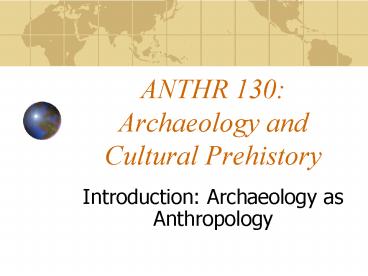ANTHR 130: Archaeology and Cultural Prehistory - PowerPoint PPT Presentation
1 / 17
Title:
ANTHR 130: Archaeology and Cultural Prehistory
Description:
Archaeology and Cultural Prehistory. Introduction: Archaeology as Anthropology ... The Classificatory/Descriptive period received its name from people wanting to ... – PowerPoint PPT presentation
Number of Views:143
Avg rating:3.0/5.0
Title: ANTHR 130: Archaeology and Cultural Prehistory
1
ANTHR 130Archaeology and Cultural Prehistory
- Introduction Archaeology as Anthropology
2
The Speculative Period 1492(?)-1840
- Nabonidus
- Petrarch
- Thomas Jefferson
- Notes on the State of Virginia
- Native American burial mounds
- systematic excavation
- reporting of finds
- research questions
3
- The Speculative Period is the age when the idea
of archaeology was conceived. - It is called the Speculative Period because this
was the time directly following Columbus's voyage
to the Americas and many people were questioning
or speculating about the new people and other
never before seen things and places in the New
World
4
- The first trend in the Speculative Period was in
the 16th and 17th centuries and primarily
concentrated on Latin America. - This trend was composed of stories and chronicles
of people (mainly priests and other
administrators) who had traveled with the Spanish
conquistadors. - These chronicles were narratives in story form
and were generally non-scientific in nature.
5
- The second trend was in the 18th and 19th
centuries and like the first trend consisted of
the narratives of explorers and travelers. - However, it differs from the first trend in that
it was more scientific in tone and method. - These people actually used scientific ideas and
methods instead of merely describing and forming
untested theories about what they observed.
6
- The third trend originated in the 18th and 19th
centuries, which overlapped the second trend. - It is differentiated from the first two trends,
because in this period, archaeology became the
main concern of the explorers and travelers. - It was not merely a byproduct of their
exploration of the area while looking for land
and gold.
7
Classificatory-Descriptive Period1840-1914
- This period is characterized by a distinct change
of attitude and outlook by many important
archaeological writers and workers who strived to
change archaeology into a scientific, systematic
discipline.
8
- The Classificatory/Descriptive period received
its name from people wanting to scientifically
classify and describe the phenomenon that they
found. These people lay the groundwork for the
twentieth century. - Franz Boas and Historical Particularism a
rejection of late 19th C. uniliner evolutionism
and an emphasis on fieldwork and collecting data
from all areas.
9
Classificatory-Historical Period I 1910-1940
- The Classificatory-Historical Period was also
concerned with scientifically classifying the
phenomenon, but differed because it also
attempted to place the information into
historical context.
10
- This period was concerned with the concept of
chronology which means placing different cultures
and artifacts within their appropriate time
periods. - It had two main trends.
- The first was concerned more with precise
scientific methods of excavation. - It stressed the importance of stratigraphic
excavation -- A.V. Kidder at Pecos Pueblo and the
development of seriation as a chronological tool
(A.L. Kreober). - It also stressed the importance of artifact
(especially pottery) typologies as aid to
seriation. - The Direct Historical Approach
11
Classificatory-Historic Period II 1940-1960
- The second trend is differentiated by the concern
with placing the artifacts found into context and
to find their function within the culture studied
and within history. - Focus
- artifacts as the material evidence of cultural
and social behavior - the relationship between culture and the natural
environment - the attention placed on the settlement patterns
of the cultures studied are characteristics of
this trend. - Low-level theory (data collection, description)
12
Explanatory Period (Processual Archaeology)
1960-Present
- The final period, the period we are presently in,
is the Explanatory Period, which started in 1960.
- This period is set apart by its concern with
evolutionary theory, general systems theory and
deductive reasoning.
13
The New Archaeology
- Unifying sense of dissatisfaction with old
theories - Wanted to test hypotheses of the past instead of
constructing chronologies - Focused more on people than on just material
culture - Focused on generalities rather than particulars
14
- New ways of doing archaeology involved
- stating of biases
- systems theory, scientific approach
- ethnographic analogy
- middle-range theory
- examining variability
15
- Main tenets
- emphasizes evolutionary generalizations, not
historical specifics - seeks universal laws
- explanation is explicitly scientific (includes
statistical procedures) - attempts to remain objective and ethically
neutral - views culture from a systemic perspective
- deals with etic phenomena
- defines culture as humanity's extrasomatic means
of adaptation - adopts a strongly positivist position
16
- Proponents
- Lewis Binford (educated at UNC - CH)
- James Deetz (last taught at UVa)
- Walter Taylor
- Examples
- Taylors A Study of Archaeology
- Binfords work with the Nunamiut Eskimos
- Deetzs work with New England grave stones
17
Post-processualism 1980- Present
- Saw a need to address cognitive factors from a
perspective that wasnt necessarily based in
science. - problems with positivism
- problems with middle-range theory and analogy
- reject ideas of processualism
- Brought together Structuralism, neoMarxism, and
feminism to generate theories and test models. - Examples
- Feminist views on artifact assemblages (Brumfiel)
- Deconstruction of tours of historical sites
(Leone) - Discovery of latent social stratification
(McGuire)































